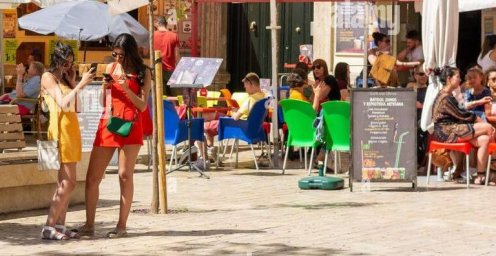The Spanish way of life
The inhabitants of this very varied country have few things in common except for a natural sociability and a zest for living. Spaniards commonly put as much energy into enjoying life as they do into their work. The stereotypical “mañana” (leave everything until tomorrow) is a myth, but time is flexible in Spain and many people bend their work to fit the demands of their social life, rather than let themselves be ruled by the clock. The day is long in Spain and Spanish has a word, madrugada, for the time between midnight and dawn, when city streets are often still lively.
Spaniards are highly gregarious. In many places people still go out in the evening for the paseo, when the streets are crowded with strollers. Eating is invariably communal and big groups often meet up for tapas or dinner. Not surprisingly, Spain has more bars and restaurants per head than any other country in Europe.
Underpinning Spanish society is the extended family. Traditionally, the state in Spain has been very inefficient at providing public services – although this has improved in the last 20 years. The Spanish have therefore always relied on their families and personal connections, rather than institutions, to find work or seek assistance in a crisis. This attitude has sometimes led to a disregard for general interests – such as the environment – when they have conflicted with private ones.
Most Spaniards place their family at the centre of their lives. Three generations may live together under one roof, or at least see each other often. Even lifelong city-dwellers refer fondly to their pueblo – the town or village where their family comes from and where they return whenever they can. Children are adored in Spain and, consequently, great importance is attached to education. The family in Spain, however, is under strain as couples increasingly opt for a higher income and better lifestyle rather than a large family. One of the most striking transformations in modern Spain has been in the birth rate, from one of the highest in Europe, at 2.72 children for every woman in 1975, to 1.39 children for every woman in 2007.
Catholicism is still a pervasive influence over Spanish society, although church attendance among those under 35 has declined in recent years to below 25 per cent. The images of saints watch over some shops, bars and lorry drivers’ cabs. Church feast days are marked by countless traditional fiestas, which are enthusiastically maintained in modern Spain.
“Vinegar Face” in Pamplona’s Los Sanfermines fiesta
Tables outside a café in Madrid’s Plaza Mayor
The windmills and castle above Consuegra, La Mancha
Virgin of Guadalupe in Extremadura
Spanish Girls
Two young Spanish women wearing red and yellow colors, Plaza de la Merced, Malaga, Andalusia
